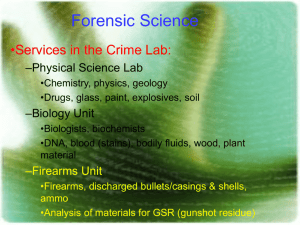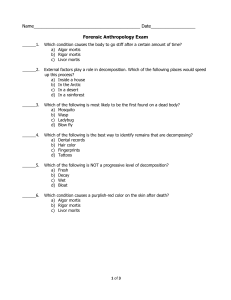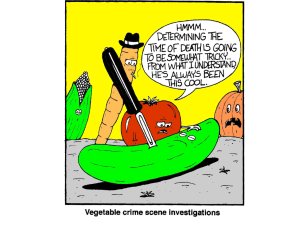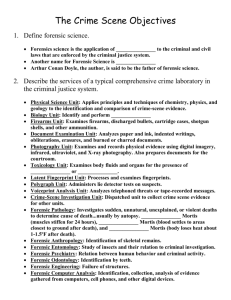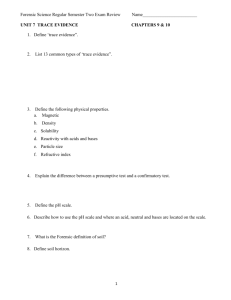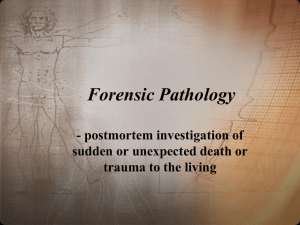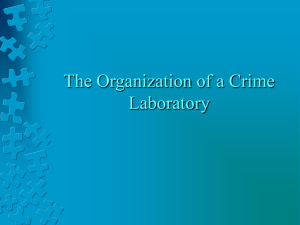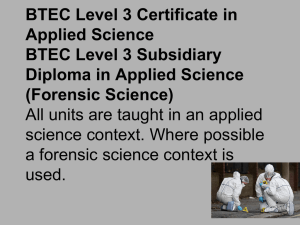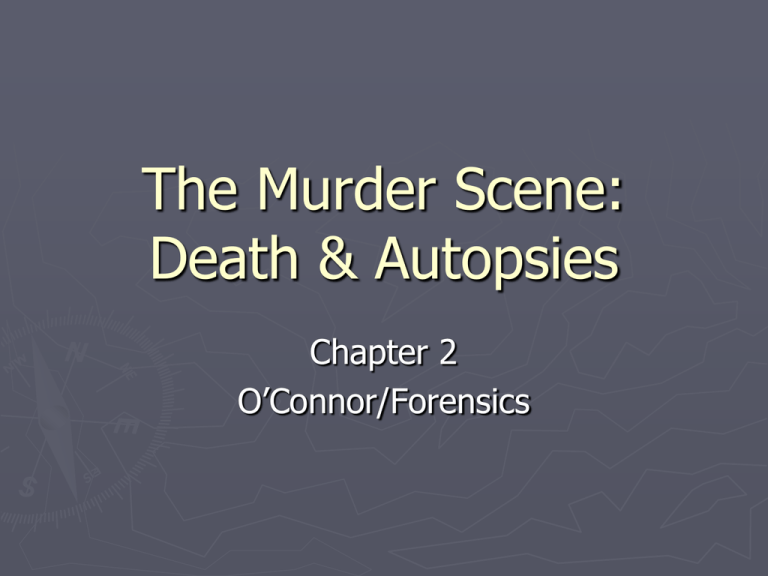
The Murder Scene:
Death & Autopsies
Chapter 2
O’Connor/Forensics
The body
► The
most important piece of evidence in a
crime scene that resulted in death is the
body.
Who Investigates?
► Primarily
the Forensic Pathologist
Aided by:
► Forensic Anthropologist
► Forensic Entomologist
Role of Forensic Pathologist
(in their role as coroner)
► They
must answer these basic questions:
► Who
is the victim?
► What injuries are present?
► When did the injuries occur?
► Why & how were the injuries produced?
► What is the cause of death?
► If
observation can’t answer these questions,
than an autopsy must be performed.
5 Classifications of cause of death
► Natural
► Homicide
► Suicide
► Accident
► undetermined
Remember!!
► Sometimes
things are not as they first
appear
► ex. Apparent suicide as murder cover-up.
► Sometimes
things are simple and there is
not more to it than what first appears.
► Ex. a rock near a body is just a rock, not a
murder weapon
Estimating time of death
► After
a human body expires it goes through
several stages of decomposition.
► It is necessary to determine time of death in
a crime.
Livor mortis
►a
settling of the blood in the lower portion of the
body, causing a purplish red discoloration of the skin:
when the heart is no longer pumping the blood, heavy
red blood cells sink due to gravity. This discoloration
does not occur in the areas of the body that are in
contact with the ground or another object.
► starts 20 minutes to 3 hours after death & is
congealed in the capillaries in 4 to 5 hours.
► It
can also be used by forensic investigators to
determine whether or not a body has been moved.
Rigor mortis
► It
commences after around 3 hours,
reaching maximum stiffness after 12 hours,
& gradually dissipates until approximately
72 hours after death. Rigor mortis occurs
due to changes in the physiology of muscles
when aerobic respiration ceases.
Algor Mortis
► the
rate at which a body cools after death.
► affected by the physiology of the individual (age,
weight, illness,) & the conditions of the environment
(temperature, clothing, surface, activity prior to
death).
► After the first hour to a period of about 6 hrs
postmortem, a body will generally cool at the rate of
1.5° F for each hour after death.
► The preferred time window for evaluating algor mortis
is within the first several hours after death. Beyond
that, the rate of cooling becomes less & less accurate
as the body temperature approaches equilibrium with
that of its environment.
interactive at morgue with Dr. G
TOUR OF A MORGUE
Interactive Autopsy
► Discovery
Health Autopsies
Forensic Anthropology
► Skeletal
detectives
► Examination of bones may reveal:
► Sex, approximate age, race & skeletal injury.
► Used not only in crimes, but also for individual
identification in mass tragedies, like a plane
crash.
Forensic Reconstruction
Computer Aided Reconstruction
1994 tourist disappearance
Body found in a shallow grave in
Capetown
Forensic Entomology
is the science of determining a time frame
and/or circumstance from the empirical
evidence of insect activity on or around the
site in question.
A time of death can be reasonably
determined by factoring in ambient
temperature , availability of corpse to
insects, and the progress of blowfly larvae
through their life cycle on that corpse.
Approximately fourteen days is necessary
for a blowfly to go from egg to adult.
Beetle Larvae
►
►
are more variable in form than fly
larvae, & there is more variation
between species in the number of
larval instars (stage of development
between moulting) - up to fourteen.
Beetles associated with carrion live in
an ephemeral environment and tend
to have short larval development
times with only two or three instars.
Most beetle larvae have chewing
mouthparts and they feed on a
variety of foods associated with
corpses.
Some are specialist predators,
feeding on fly larvae, while others
feed on dry flesh, skin, ligaments
and hair.
Stages of decomposition as seen in
piglets
► Why
piglets?
► A 40 kg pig resembles a human body in its fat
distribution, cover of hair and ability to attract
insects. These factors make pigs the next best
things to humans when it comes to understanding
the process of decay of the human body.
► The pigs in this website are newborn piglets
(weighing about 1.5 kg) that have been
accidentally crushed by their mothers - a key
cause of death of piglets. Their bodies have been
donated to science.
Stage 1- living pig
Stage 2: Initial decay - 0 to 3 days
after death
Stage 3: Putrefaction - 4 to 10 days
after death
Stage 4: Black putrefaction - 10 to
20 days after death
Stage 5: Butyric fermentation - 20
to 50 days after death
Stage 6: Dry decay - 50-365 days
after death
Science reveals secrets of death

